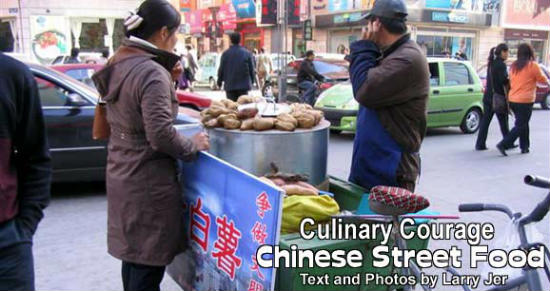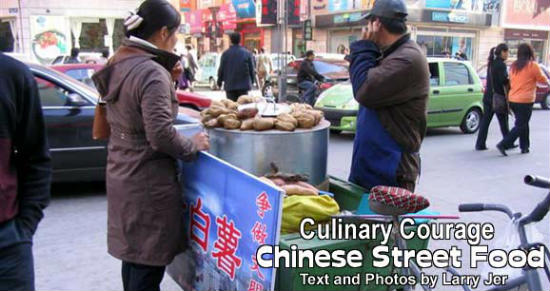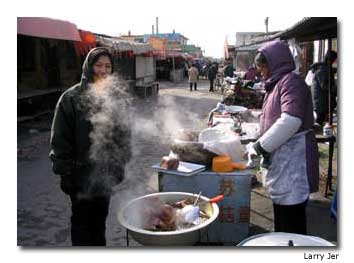

“Eat anything that flies except airplanes; eat anything with legs except the table.”|
Anonymous (but I will take credit for it if no one else will.)
I will be diplomatic and say that Chinese street food, to my taste, was like taking my taste buds to the circus. Eating street cuisine in China did not come easily to me.
Without ever having set foot in The Middle Kingdom, I signed a contract to teach English in Shenyang, a day’s train ride northeast of Beijing. Shenyang is heavy into industry, and is more known for its sooty air quality than as a haven of epicurean delight. (The air is sometimes so chunky with particulate matter, it might actually qualify as a side dish or at the very least, a condiment.)
I struggled with the language at first. Compliments of my Chinese immigrant parents, I have a smattering of Cantonese at my disposal, but living in northeastern China required Mandarin — and lots of it, more than my Lonely Planetphrasebook served up, that’s for sure.
I lost 25 pounds over 10 months that first year, a change so dramatic I could have marketed this diet. I was never hungry, yet I was soon punching new holes on the negative side of my belt.
The tongue-in-cheek Chinese adage, “Eat anything that flies except airplanes; eat anything with legs except the table,” is one that describes the culinary attitude of the local people. Logic follows that with a 1.3 billion– plus population, every niblet and giblet, each root, everything Fear Factor-ish, will have been taste tested at some point.
If the morsel has potential, it is often afforded an exotic name, then served up with smothering sauces and an inflated tab. In this regard, I believe I have been included in several focus groups without my ever having known.
I was born and raised in North America. My parents left their first life in China, hustled my brothers and sisters though foreign and domestic channels, and settled on Canada’s west coast. Now, true to Great White North tradition, all foodstuffs deemed inedible or unsightly are disposed of, ground up in the garbage disposal, vaporized; atomic-sized remnants are chased into oblivion by antibacterial sprays so even their essence would no longer exist to offend. So what happened?
Why delve into street fare? Why, indeed, rock the rickshaw? Well, in my early days in China, each day as I rode past countless street vendors, the aroma of barbecuing lamb, fresh pastries and grilled seafood, teased me with their tantalizing bouquets, the siren scents chasing me back to my flat, where I would sit and contemplate my roomy slacks. Those heady days, I hadn’t yet the will to challenge my stomach mettle or my burgeoning language skills.
At lunchtime I always arrived at the common dining hall with great anticipation. I used my prepaid food vouchers with abandon, one for steamed rice, two more for a brown or green main dish, stir-fried in the massive kitchen with a shovel in a wok the size of a satellite dish, by a steely-armed cook wearing hip waders (true). Unfazed, I tossed down the meals with as much élan as the students did, and more, because, sadly, I couldn’t afford to shed any more body weight, my body mass dropping like it had no emergency chute.
Not only for necessity and weight concerns, I decided to explore the city’s food subculture as another aspect of life in China, an added dimension. The inviting smells my nose picked up on my way to school and back had whetted my appetite. Now, I afforded my palate tiny day trips as I began stopping by the vendors’ carts and munch my way through the exotic tastes of China.
Street food is easier to order than a meal in any traditional restaurant. You can see exactly what you’re getting, watch them prepare it and, without ever having to call it by name (or even identify it), you can always just say zai lai yi ge . This useful phrase means “one more, please.” Regardless of whether you have another, though, you can feel free to continue to the next vendor’s goody wagon.
But don’t stop at just any vendor: Look for the one who keeps a regular corner and boasts a crowd around lunchtime. A smiling, happy crowd, mind you, and not the type huddled around a fellow snacker who’s clutching his stomach and threatening litigation.
The busy-ness of the peddler speaks well for the quality, freshness and taste-quotient of their product. And need I add: Keep away from trays of stale food whose only customers are the non-paying variety: flies and family members. Listen to your Inner Mother before indulging.
They say you never forget your first. They’re right. Mine was five lamb kebabs for a yuan (about 13 cents). I was not at all deterred by the fact that a few British expatriates called the pungent tidbits “hepatitis on a stick.” As I stood astride my flashy red girl’s bike enjoying my treats, my senses must certainly have been heightened. How else could I notice that the kebabs were in fact, skewered on old bicycle spokes? Enterprising Chinese have found a new way to recycle a cycle!

With repeated visits, feeling proud and full after devouring my kebabs or silkworm (yes, you read correctly, I do indeed mean silkworm!) or chicken necks, I’d peddle on home with that tangy aftertaste of cumin still tickling my lips.
But a man who has lost 14 percent of his body weight cannot live by bike-spoke kebabs alone … there should be some soup with that.
This brought me round to a little roadside dining establishment near my flat featuring wontons boiled and served from a three-wheeled buggy. Around this cart stood four sawhorses that passed for ambiance and down-home practical seating.
I kicked down my bike stand and joined the boy’s club, happily ordering my bowl of wontons. Three men sat sipping their soup out of criminally shallow spoons, each patron balanced with ease on his respective two-by-four sawhorse. When it came time for me to park my westernized behind on the only horse remaining, I kept sliding and constantly catching my balance.
I chalked up my sudden vertigo to inexperience or the vagaries of metric conversion. It turned out the others had the deluxe sawhorses, and sat on the four-inch (10 cm) side, while my sawhorse offered the meager two-inch (5 cm) side for a seat. Alas, I wore a lot of my soup home that first night, creating a new, yet tasty, fashion statement.
These days, in a perfectly scrubbed suburb of Vancouver, it’s been a year and an eternity since rolling through the streets of Shenyang. Can I honestly say I miss the befouled air, chopsticks that have never seen soapy water, cooks in hip waders? How can I not miss it?
But take heart, I have been secretly amassing ingredients and, at my next cookout, I vow to spear some spiced treats onto fatigued bicycle spokes. Now, where can I get some live silkworm?
- The Low-Key Magic of Ghent, Belgium - April 22, 2024
- Discover the Hidden Charm of Extremadura in Spain - April 20, 2024
- Life of a Champion: Exploring the Muhammad Ali Center in Louisville - April 19, 2024
